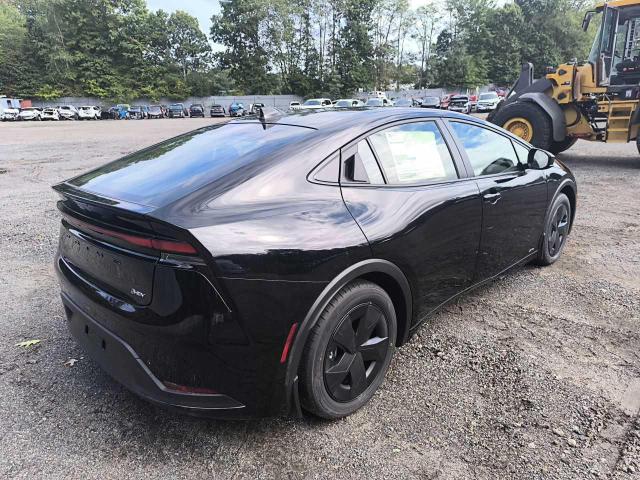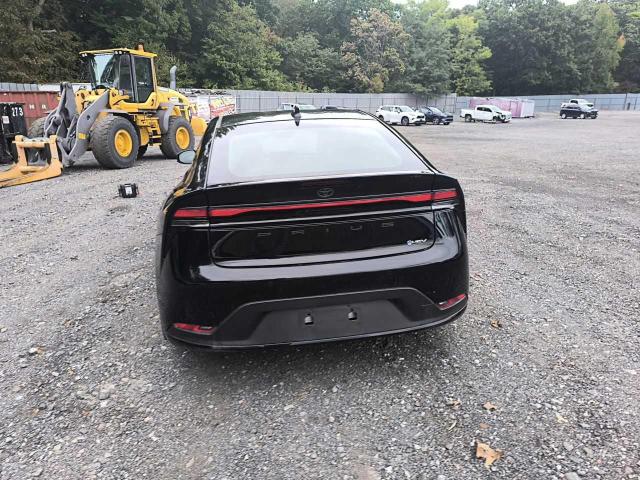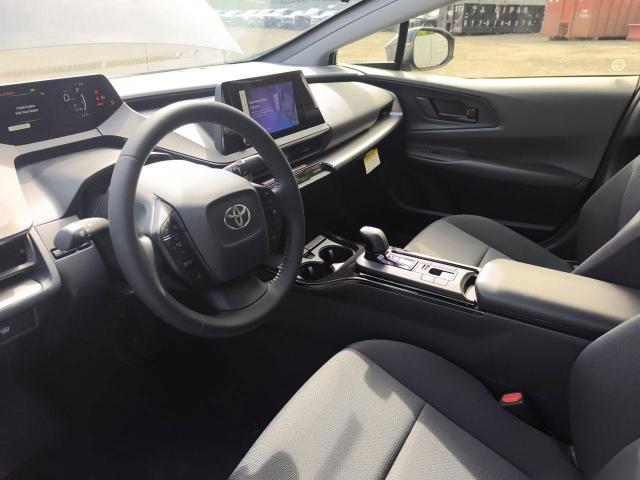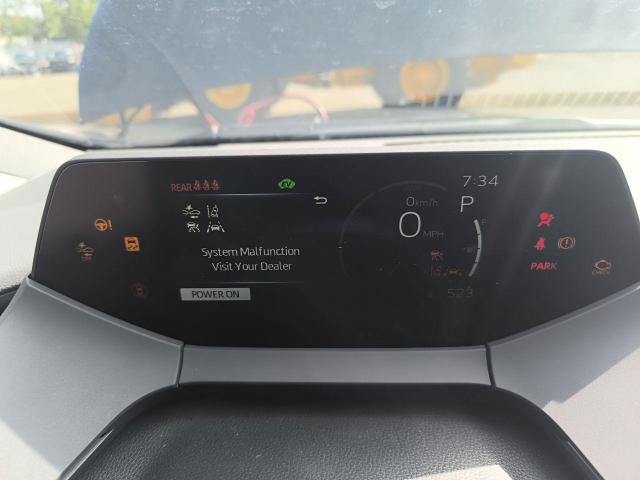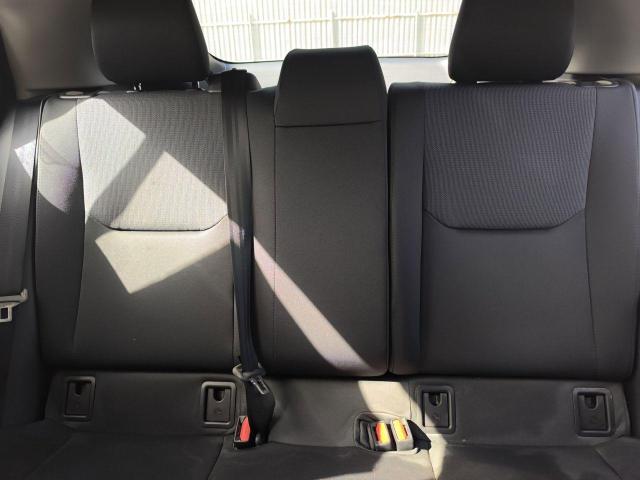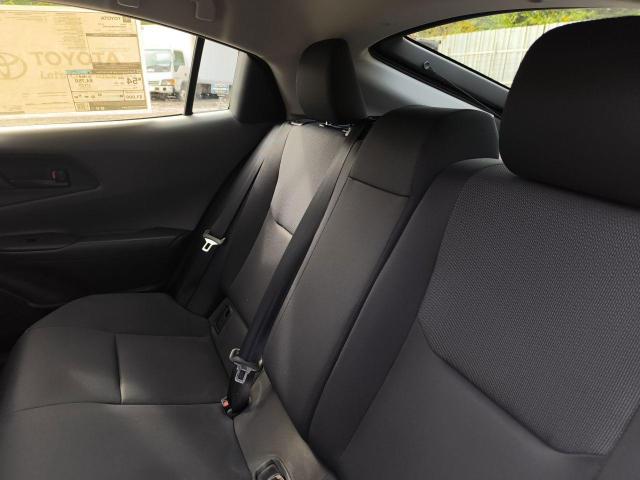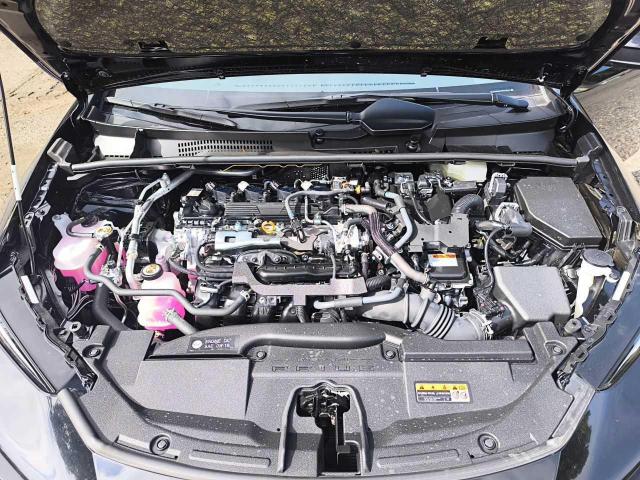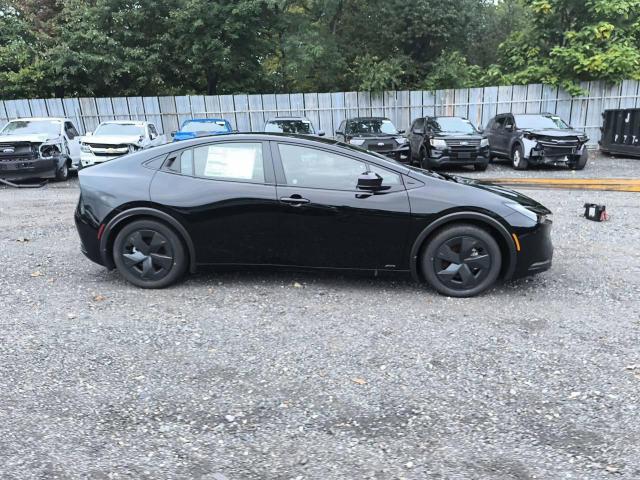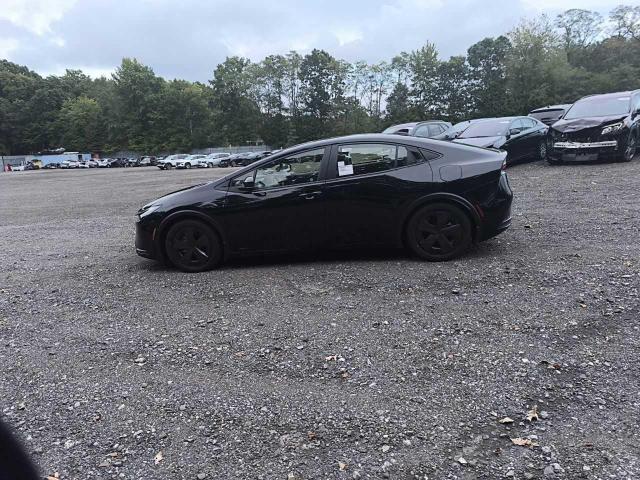2024 TOYOTA PRIUS | JTDADABU4R3013862
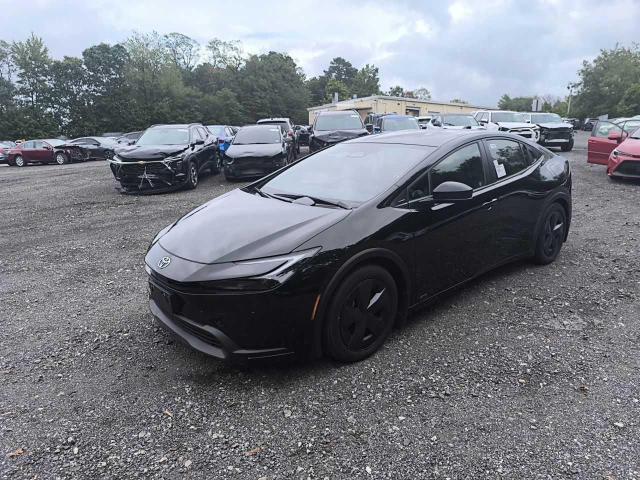 ❯
❯
Specifications
2
~$34,000
Engine: 2.0L hybrid I4 with electric motor
Torque: 190 Nm (gas) + 206 Nm (motor)
0–100 km/h: ~7.0 s
The 2023+ Toyota Prius is no longer just about efficiency — it’s also genuinely quick. The new 2.0L hybrid system produces a combined 196 hp in AWD form (194 hp in FWD), which slashes the 0–100 km/h time to about 7 seconds — over 2 seconds faster than the previous generation. That’s a transformative improvement that puts it on par with many compact sedans. The hybrid system responds quickly to throttle input, and electric motor torque provides instant off-the-line performance, making city driving and highway merging feel light and agile.
The TNGA-C platform brings a stiffer chassis, lower center of gravity, and better weight distribution. Suspension tuning has improved dramatically, reducing body roll and delivering surprising composure in corners. Steering is direct, and regenerative braking is well integrated. It’s not a performance car, but it offers a much more dynamic and enjoyable experience — turning the Prius from a point-A-to-B tool into something that can actually be fun to drive.
This new Prius proves that efficiency and performance are no longer opposites, delivering responsive, well-rounded dynamics in a sleek hybrid package.
Body Styles
The 2023+ Prius is a compact five-door liftback, now styled more like a futuristic coupe than a traditional hybrid. It sits low and wide, with a sharply tapered roofline, narrow LED headlights, sculpted fenders, and full-width rear lighting. The new design emphasizes sleekness and sportiness, departing completely from the tall, upright shape of earlier generations. Despite its coupe-like form, it retains excellent rear cargo access via a hatchback tailgate and provides respectable headroom in both rows. Overall, the Prius has transitioned from utilitarian to design-forward and aerodynamically elegant.
Model Name Meaning (Manufacturer)
The name Toyota Prius was chosen to emphasize the vehicle’s groundbreaking role as the first mass-produced hybrid car, highlighting its position as a technological forerunner. The word “Prius” comes from Latin, where it means “before”, “prior,” or “ahead.”
Toyota selected this name to reflect the Prius’s pioneering spirit — a vehicle that arrived before its time, ushering in a new era of eco-conscious mobility. When the Prius debuted in 1997 (globally) and 2000 (in North America), it symbolized Toyota’s commitment to innovation, environmental responsibility, and efficiency. The name captured its role as a trailblazer in hybrid technology, well ahead of industry and consumer trends.
From the manufacturer’s perspective, “Prius” is also short, memorable, and phonetically clear in many languages. It avoids cultural or linguistic complications, making it globally neutral and easy to market across regions. The name conveys progressiveness without being aggressive, aligning with Toyota’s brand image as practical, reliable, and future-focused.
Model Name Meaning (Languages)
“Prius” has a clear and consistent meaning in multiple languages, reinforcing its role as a forward-looking, pioneering vehicle. It’s one of the few hybrid nameplates recognized globally, giving it strong brand equity in the green mobility space.
Body & Interior Colors and Rims
The new Prius comes in bold and modern colors such as Cutting Edge, Guardian Gray, Supersonic Red, Wind Chill Pearl, Reservoir Blue, and Midnight Black. Some trims offer two-tone black roofs and exclusive finishes. The body features sharp creases, gloss-black accents, flush door handles (on higher trims), and an elegant “hammerhead” front lighting signature.
Inside, the cabin features a clean, horizontal layout with improved materials and a premium ambiance. The driver sits lower than in previous models, and the dashboard integrates a centrally placed 12.3-inch infotainment screen (on XLE/Limited) and a 7-inch digital gauge cluster positioned high on the dash. Interior colors include Black, Light Gray, and optional two-tone combinations. Materials range from soft-touch plastics and fabric on base trims to leatherette and ambient lighting in higher trims. The overall design is functional yet stylish, with more intuitive controls and a greater sense of space and tech.
Wheel sizes vary from 17-inch silver alloys (LE) to 19-inch machine-finished or black alloys (XLE and Limited), with aerodynamic inserts that improve efficiency. Larger wheels give the Prius a planted, athletic stance while maintaining low drag coefficients.
Top Expensive Options
- Limited Trim Package (Leatherette Seats, JBL Audio, Digital Key): $4,000
- 12.3" Toyota Audio Multimedia with Cloud Navigation: $1,200
- Panoramic View Monitor with Parking Assist: $900
- Heated and Ventilated Front Seats + Heated Rear Seats: $750
- Fixed Glass Roof with Retractable Shade: $1,000
- Digital Rearview Mirror with HomeLink: $500
- Advanced Park Assist (Hands-Free Parking): $600
- Wireless Charging Pad + Rear USB-C Ports: $350
- Blind Spot Monitor with Rear Cross-Traffic Braking: Standard (XLE+)
- Adaptive Front Lighting System with Cornering LEDs: $800
vs Competitors
The 2023+ Prius competes with the Hyundai Elantra Hybrid, Honda Insight (discontinued), Hyundai Ioniq Hybrid (discontinued), and even compact EVs like the Chevy Bolt EUV. Compared to older hybrids, the Prius now offers superior performance, better styling, and a dramatically more refined cabin. Against plug-less competitors, it delivers unbeatable real-world fuel economy (up to 57 mpg combined), and unlike EVs, there’s no range anxiety. Compared to EVs, it’s more affordable and charging-free. With its AWD availability, sleek new design, and elevated tech, the Prius has gone from an eco badge to a well-rounded, stylish, and future-forward daily driver.
Fun Fact
The 2023 Prius is the first in its lineage to be quicker than a base Toyota Corolla, and its AWD version accelerates faster than a 1990s Supra Turbo automatic. It also uses Toyota’s fifth-generation hybrid system, which is 30% smaller and more efficient than the previous generation — proving that green tech can now coexist with strong performance and sleek aesthetics.
Lot Details
-
Sale Date23/May/2025
-
Lot Number74573904
-
Location
-
Odometer6 miles (10 km)
-
Primary Damage:WATER/FLOOD
-
Fuel
-
Engine Type2.0L 4
-
Drive Type
-
Color
Final Bid Toyota Prius (2024)
$10,000
$12,580
$23,000
Specifications
2
~$34,000
Torque:
0–100 km/h:
The 2023+ Toyota Prius is no longer just about efficiency — it’s also genuinely quick. The new 2.0L hybrid system produces a combined 196 hp in AWD form (194 hp in FWD), which slashes the 0–100 km/h time to about 7 seconds — over 2 seconds faster than the previous generation. That’s a transformative improvement that puts it on par with many compact sedans. The hybrid system responds quickly to throttle input, and electric motor torque provides instant off-the-line performance, making city driving and highway merging feel light and agile.
The TNGA-C platform brings a stiffer chassis, lower center of gravity, and better weight distribution. Suspension tuning has improved dramatically, reducing body roll and delivering surprising composure in corners. Steering is direct, and regenerative braking is well integrated. It’s not a performance car, but it offers a much more dynamic and enjoyable experience — turning the Prius from a point-A-to-B tool into something that can actually be fun to drive.
This new Prius proves that efficiency and performance are no longer opposites, delivering responsive, well-rounded dynamics in a sleek hybrid package.
Body Styles
The 2023+ Prius is a compact five-door liftback, now styled more like a futuristic coupe than a traditional hybrid. It sits low and wide, with a sharply tapered roofline, narrow LED headlights, sculpted fenders, and full-width rear lighting. The new design emphasizes sleekness and sportiness, departing completely from the tall, upright shape of earlier generations. Despite its coupe-like form, it retains excellent rear cargo access via a hatchback tailgate and provides respectable headroom in both rows. Overall, the Prius has transitioned from utilitarian to design-forward and aerodynamically elegant.
Model Name Meaning (Manufacturer)
The name Toyota Prius was chosen to emphasize the vehicle’s groundbreaking role as the first mass-produced hybrid car, highlighting its position as a technological forerunner. The word “Prius” comes from Latin, where it means “before”, “prior,” or “ahead.”
Toyota selected this name to reflect the Prius’s pioneering spirit — a vehicle that arrived before its time, ushering in a new era of eco-conscious mobility. When the Prius debuted in 1997 (globally) and 2000 (in North America), it symbolized Toyota’s commitment to innovation, environmental responsibility, and efficiency. The name captured its role as a trailblazer in hybrid technology, well ahead of industry and consumer trends.
From the manufacturer’s perspective, “Prius” is also short, memorable, and phonetically clear in many languages. It avoids cultural or linguistic complications, making it globally neutral and easy to market across regions. The name conveys progressiveness without being aggressive, aligning with Toyota’s brand image as practical, reliable, and future-focused.
Model Name Meaning (Languages)
“Prius” has a clear and consistent meaning in multiple languages, reinforcing its role as a forward-looking, pioneering vehicle. It’s one of the few hybrid nameplates recognized globally, giving it strong brand equity in the green mobility space.
Body & Interior Colors and Rims
The new Prius comes in bold and modern colors such as Cutting Edge, Guardian Gray, Supersonic Red, Wind Chill Pearl, Reservoir Blue, and Midnight Black. Some trims offer two-tone black roofs and exclusive finishes. The body features sharp creases, gloss-black accents, flush door handles (on higher trims), and an elegant “hammerhead” front lighting signature.
Inside, the cabin features a clean, horizontal layout with improved materials and a premium ambiance. The driver sits lower than in previous models, and the dashboard integrates a centrally placed 12.3-inch infotainment screen (on XLE/Limited) and a 7-inch digital gauge cluster positioned high on the dash. Interior colors include Black, Light Gray, and optional two-tone combinations. Materials range from soft-touch plastics and fabric on base trims to leatherette and ambient lighting in higher trims. The overall design is functional yet stylish, with more intuitive controls and a greater sense of space and tech.
Wheel sizes vary from 17-inch silver alloys (LE) to 19-inch machine-finished or black alloys (XLE and Limited), with aerodynamic inserts that improve efficiency. Larger wheels give the Prius a planted, athletic stance while maintaining low drag coefficients.
Top Expensive Options
- Limited Trim Package (Leatherette Seats, JBL Audio, Digital Key): $4,000
- 12.3" Toyota Audio Multimedia with Cloud Navigation: $1,200
- Panoramic View Monitor with Parking Assist: $900
- Heated and Ventilated Front Seats + Heated Rear Seats: $750
- Fixed Glass Roof with Retractable Shade: $1,000
- Digital Rearview Mirror with HomeLink: $500
- Advanced Park Assist (Hands-Free Parking): $600
- Wireless Charging Pad + Rear USB-C Ports: $350
- Blind Spot Monitor with Rear Cross-Traffic Braking: Standard (XLE+)
- Adaptive Front Lighting System with Cornering LEDs: $800
vs Competitors
The 2023+ Prius competes with the Hyundai Elantra Hybrid, Honda Insight (discontinued), Hyundai Ioniq Hybrid (discontinued), and even compact EVs like the Chevy Bolt EUV. Compared to older hybrids, the Prius now offers superior performance, better styling, and a dramatically more refined cabin. Against plug-less competitors, it delivers unbeatable real-world fuel economy (up to 57 mpg combined), and unlike EVs, there’s no range anxiety. Compared to EVs, it’s more affordable and charging-free. With its AWD availability, sleek new design, and elevated tech, the Prius has gone from an eco badge to a well-rounded, stylish, and future-forward daily driver.
Fun Fact
The 2023 Prius is the first in its lineage to be quicker than a base Toyota Corolla, and its AWD version accelerates faster than a 1990s Supra Turbo automatic. It also uses Toyota’s fifth-generation hybrid system, which is 30% smaller and more efficient than the previous generation — proving that green tech can now coexist with strong performance and sleek aesthetics.




